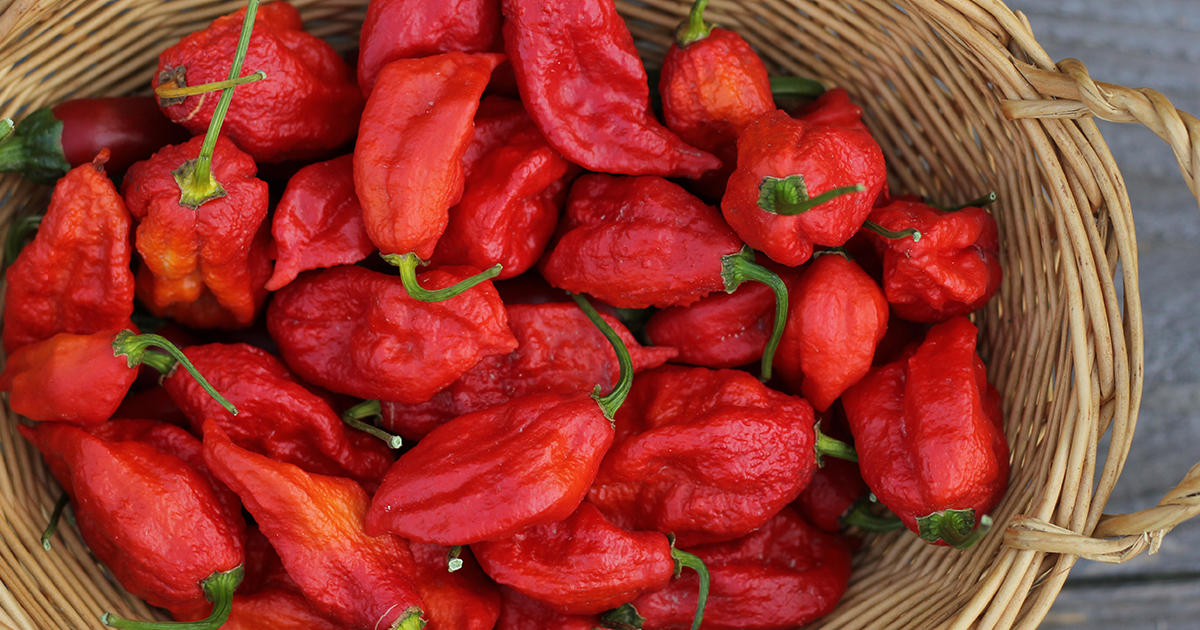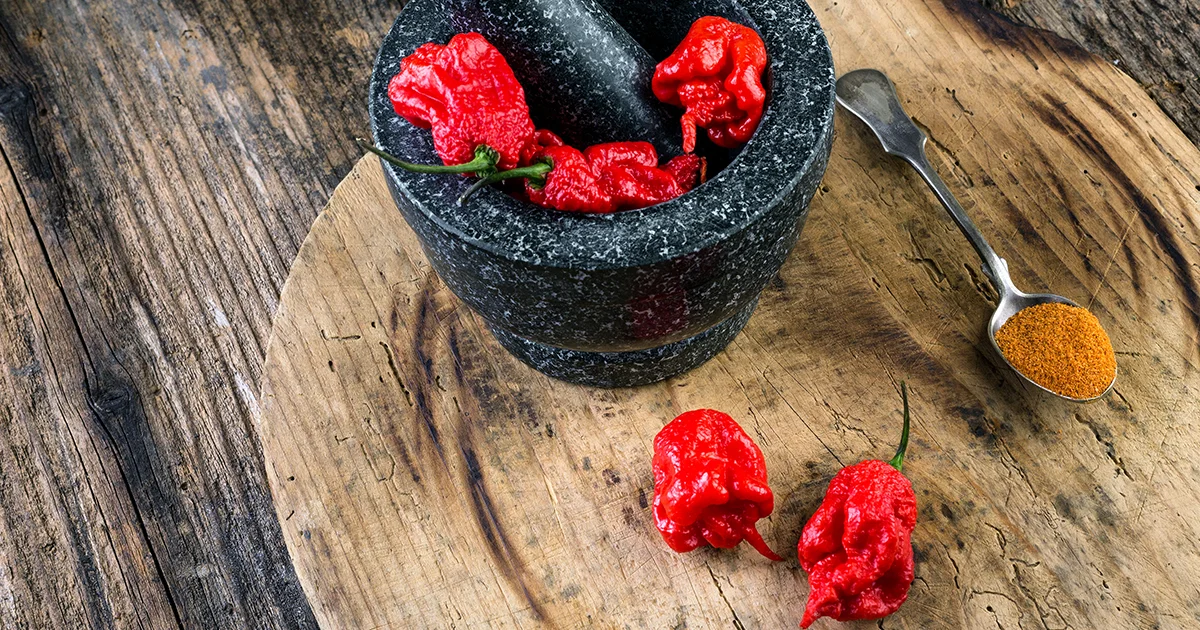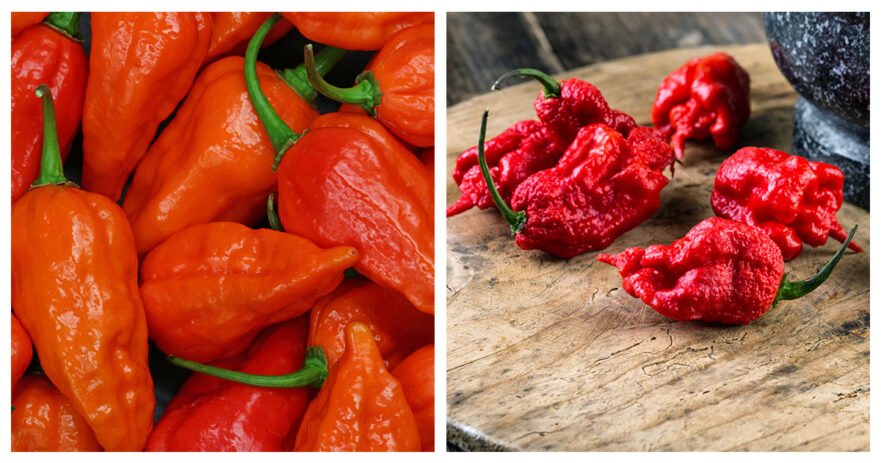If you’re a lover of the feeling of your tongue on fire with spice, then you’re probably no stranger to munching on hot peppers. But have you ever wondered about the battle between ghost peppers and the Carolina Reaper? The two of these scary-sounding peppers are some of the hottest in the world, and they pack a wild punch that’s not for the faint of heart. In this article, we’ll work to compare the heat levels, flavors, and uses of ghost peppers and the Carolina Reaper to help you decide which one is right for you.
| Ghost pepper | Carolina reaper pepper | |
| SHU | 855,000 - 1,041,427 | 1,400,000 - 2,200,000 |
| Median SHU | 948,214 | 1,800,000 |
| Flavor | Fruity and slightly sweet, with a very intense heat | Fruity and sweet, with an intense and lasting heat |
| Species | Hybrid of Capsicum chinense x Capsicum frutescens | Capsicum chinense, Hybrid (Naga pepper x Habanero) |
| Origin | Northern India | South Carolina, USA |
| Uses | Hot sauces, salsas, curries, pickling, etc. | Hot sauces, salsas, chili, marinades, etc. |
Table of contents
What are Ghost Peppers?

Ghost peppers, also known as bhut jolokia, are a type of chili pepper that originated in Northeast India. These peppers are notoriously hot, with a Scoville rating that can reach up to 1,041,427. To give you a little perspective on what we mean by that, a jalapeño pepper typically ranges between 2,500 to 8,000 Scoville units, making ghost peppers over 100 times hotter than a jalapeño.
In terms of appearance, ghost peppers are small and conical in shape, usually with wrinkled, red, or orange skin.
Ghost peppers have a unique flavor with little hints of sweetness and fruitiness, followed by an intense and lingering heat. While ghost peppers may be intimidating to some, they‘re actually super versatile in the kitchen. Their unique flavor profile means that ghost peppers can add so much more than just heat to a dish. They‘re delicious when mixed with ingredients like ginger, garlic, and coconut milk, making them a definite staple in lots of Southeast Asian curries. Ghost peppers can also be used to make infused oils or vinegar, which can be added to dishes to provide a spicy kick.
Ghost peppers have definitely gained a reputation for being one of the hottest peppers in the world. As a result, they have become a popular topic of conversation among chili enthusiasts. Ghost pepper challenges have become a hilariously popular trend on social media, in which people attempt to eat a whole ghost pepper without melting.
What is the Carolina Reaper?

The Carolina Reaper is a hybrid pepper that was created by Ed Currie of PuckerButt Pepper Company in South Carolina. In 2017, it was officially declared the world’s hottest chili pepper by Guinness World Records. The Scoville rating of these hot little guys can reach up to 2,200,000! The Carolina Reaper’s heat is crazily intense and lasts for a good while, and it can actually cause severe reactions in people who are sensitive to spicy foods. So, eat with caution!
In terms of flavor, the Carolina Reaper has a fruity and slightly sweet taste, followed by an intense heat that can last for several minutes. It‘s frequently used in things like BBQ sauces, salsas, and rubs to add heat and flavor to meat-based dishes like chicken wings or ribs.
Carolina Reaper peppers are usually around 2-2.5 inches long, and they’ve got a bumpy texture and red color. They are definitely more challenging to grow than ghost peppers, because they require super specific growing conditions to thrive.
If you‘re brave enough to give the Carolina Reaper a try, it‘s crucial to remember to handle the pepper with extreme caution. The capsaicin in this particular pepper can cause severe skin and eye irritation, so you have to wear gloves and avoid touching your face while working with the pepper. It’s also recommended to start with small amounts and gradually increase the heat level in your dishes to avoid any adverse reactions.
What are the similarities between Ghost peppers and the Carolina Reaper?
Ghost peppers and Carolina Reaper peppers are both highly sought after by spicy food enthusiasts, and they share many similarities that set them apart from other chili peppers.
First and foremost, both peppers are insanely hot, with a Scoville rating that can reach over a million units. This makes them significantly hotter than other commonly used chili peppers like jalapeños and habaneros.
Despite their serious heat, both peppers come with a unique and complex flavor. Ghost peppers and Carolina Reaper peppers are known for their sweet and fruity taste, followed by an intense heat that lingers on the tongue.
When it comes to looks, both Ghost peppers and Carolina Reaper peppers are small and cone-shaped, and they have a bumpy texture. They‘re also both a shade of red in color when they‘re fully ripe.
Growing these peppers can be quite challenging, and they each require specific growing conditions to thrive. Both need warm temperatures, plenty of sunlight, and well-draining soil to produce the best results. Even then, these peppers can be difficult to grow, and many home gardeners choose to purchase them from specialty stores instead.
What are the differences between Ghost peppers and the Carolina Reaper?
Both Ghost peppers and Carolina Reaper peppers are incredibly hot, but there are distinct differences in their heat level, appearance, growing conditions, and culinary uses.
Ghost peppers have a top Scoville rating of around 1,000,000, while Carolina Reapers can reach Scoville ratings up to 2,200,000, which makes them the number one hottest chili pepper in the world.
Ghost peppers are more popularly used in Indian and Southeast Asian cuisines, where they are perfect for adding heat and flavor to curries, chutneys, and more. On the flip side, Carolina Reaper peppers are more commonly used in American-style hot sauces and meat rubs.
Because of this difference in heat level, Ghost peppers are a little more ideal to add heat to dishes without totally overpowering the flavor, while Carolina Reaper peppers are used when a significant and slightly scary heat boost is desired.
Another difference that can be found between the two peppers is how they look. Carolina Reapers are generally a little smaller than Ghost peppers and have a more noticably bumpy texture. Another is that Ghost peppers have a lighter reddish and sometimes orange skin, Carolina Reapers usually have a deeper red color.
FAQ about ghost peppers and carolina reaper
What makes Ghost Peppers and Carolina Reapers so hot?
Ghost Peppers and Carolina Reaper contain a high amount of capsaicin, which is a chemical compound that‘s responsible for the heat in chili peppers. Ghost Peppers can reach up to 1,000,000 Scoville units, while the Carolina Reaper gets up to Scoville ratings of 2,200,000, making it the hottest chili pepper in the world.
What are the flavors of Ghost Peppers and Carolina Reaper?
Both the Carolina Reaper and the Ghost Peppers have a fruity, slightly sweet flavor before an intense heat that sticks around for a while.
Can Ghost Peppers and Carolina Reaper be used in cooking?
Absolutely, both peppers can be used in cooking to add heat and flavor to dishes! Ghost Peppers pair well with flavors like ginger, garlic, and coconut milk, which makes them a popular staple in many Southeast Asian curries. The Carolina Reaper is often used in more American items like sauces, salsas, and rubs to add heat and flavor to meat dishes.
How can I handle Ghost Peppers and Carolina Reapers safely?
Both Ghost Peppers and Carolina Reapers are extremely hot because they are chock full of capsaicin. which can cause serious skin and eye irritation. You’ve got to remember to wear gloves and avoid touching your face while handling these peppers. You should probably also start by tasting a small amount and very slowly increase the heat level in your dishes to avoid any painful reactions.
Are there alternative peppers that are less spicy than Ghost Peppers and Carolina Reapers?
Oh, absolutely! If you're looking for a less-spicy alternative, you can try using jalapeños or habanero peppers, which have a milder heat level but still add a big hit of flavor to dishes. It's still important to note that even these peppers can be quite hot, so start off with small amounts and gradually increase over time.

